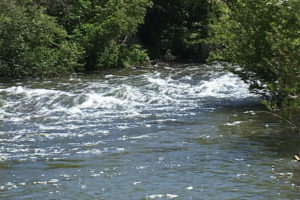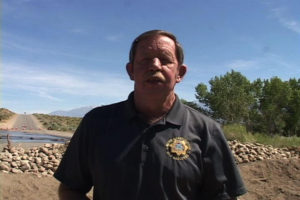By Deb Murphy
Last week, we asked a few of the agencies watching record snow fall melt and surge into the Owens Valley when to expect the big run-off—an event they’ve all been preparing for over the last four or five months.
Their answer: this week.
After near to below normal temps and little rainfall this spring, Mother Nature let loose with a heat wave and mountain rain squalls. Last Friday, the Big Pine Creek was sending 70 cubic feet per second down the bypass leaving a safe 200 cfs to course through town.
Friday’s bypass cfs was reduced to a trickle by the time the pole road turned south. By Tuesday morning, more than 170 cfs was diverted, flooding Newman Road southeast of Big Pine. The Bishop Creek was close to jumping its banks at the diversion—the diversion sent serious water over Brockman Lane.
According to Greg Loveland, Los Angeles Department of Water and Power’s manager of northern aqueduct operations and water conservation, there are a lot of eyes on Bishop Creek, the department, the county and Bishop Fire Department. “Anything above 300 cfs makes everybody nervous,” he said.
Equipment has been staged at pinch points along the creek to pull out debris clogging the system and remove silt build-ups.
Last Wednesday, Loveland’s prediction of when the big run-off would start was “soon.” “Once the snow pillows go to zero,” he said referring to locations where the water equivalent of the snow pack is measured, “the run-off should peak in around 30 days. The pillows at Big Pine, Bishop, Rock Creek and Cottonwood have been at zero for a while.”
LADWP has had the National Ocean and Atmospheric administration on speed dial, getting predictions three to seven days out. Worst case scenario: rain on snow and high temperatures.
Crowley Lake was dropped to around 80,000 acre-feet, 103,000 a-f below its capacity. Now it’s filling up again. According to Loveland, Southern California Edison is managing its reservoirs at Sabrina and South lakes the same way: drop the levels to make room for what’s coming.
One happy element of the department’s management of the run-off is water spreading wherever possible. “The aqueduct capacity is 700 cfs,” Loveland said. “We’re spreading more water in the valley than we’re sending to Los Angeles.”
Inyo County’s Public Works Department’s preparation work has mirrored LADWP’s: clear channels, build up berms to control breached culverts and stage equipment at critical points. Director Clint Quilter stays abreast of where LADWP is sending water and what to look for. “The cooperation (with the department) has been very good,” he said.
While the prep work has been done, the focus shifts to the Lower Owens River. Public Works’ road department is responsible for maintaining the network of roads impacted by heavy flows in the river channel. In some areas the spread has reached road shoulders and overflowed at culvert crossings.
Under the 1997 Memorandum of Understanding, LADWP has to maintain a flow of 40 cfs at the pump back station, requiring around 80 cfs at the Owens River intake. Yesterday, the flow at the intake was 277 cfs, 75 at the pump back.
For Inyo County Sheriff Bill Lutze, the goal is to keep people from injury or worse. His department has been issuing regular press releases on the hazards of high water for recreators and the importance of keeping ditches cleared for home owners.
“The river banks are undermined,” he said. “People need to keep their pets on leashes and their kids close.” His basic message: stay away from the river. Helicopters involved in the retrieval of a fatality below Tinnemaha clocked the surface flow at 40 miles per hour. “The under tow is even greater,” he said.
As a dramatic end to the southwest’s five-year drought, this run-off season is a case of “be careful what you ask for.”




















